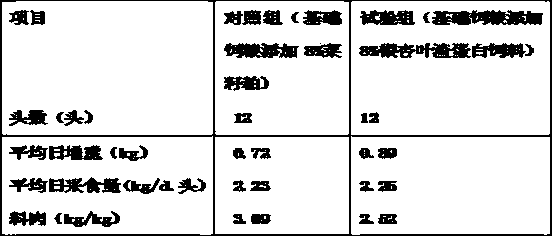Method for producing protein feed through mixed strain solid-state fermentation of ginkgo leaf residue
A technology of ginkgo biloba residue and solid-state fermentation, applied in animal feed, animal feed, application, etc., can solve the problems of low nutritional value, low protein content of fermented feed, poor digestion and absorption, etc., and achieve the effect of high nutritional value
- Summary
- Abstract
- Description
- Claims
- Application Information
AI Technical Summary
Problems solved by technology
Method used
Image
Examples
Embodiment 1
[0049] Strain culture
[0050] a. Expansion culture of Candida tropicalis: activate Candida tropicalis and inoculate it into a large test tube containing 5 mL of wort medium, culture it at 28°C for 24 hours, and then inoculate it with 5% inoculum in a large test tube containing 500 mL of wort medium. In the Erlenmeyer flask of the wort medium, culture it on a constant temperature shaker (180r / min) at 28°C for 36h to obtain a liquid strain of Candida tropicalis.
[0051] b. Amplification culture of Aspergillus oryzae: activate Aspergillus oryzae and inoculate it into a large test tube containing 5mL Czapek's liquid medium, culture at 28°C for 24h, and then inoculate 5% of the inoculum into a triangle containing 500mL Czapek's liquid medium In the bottle, culture it on a constant temperature shaker (180r / min) at 28°C for 36h to obtain liquid strains of Aspergillus oryzae.
[0052] c. Expansion culture of Bacillus subtilis: activate Bacillus subtilis and inoculate it into a larg...
Embodiment 2
[0061] Preparation of solid-state fermentation medium
[0062] After drying and crushing the ginkgo leaf residue, add water 2 to 4 times the weight of the ginkgo leaf residue, then add a nitrogen source with 5 to 12% of the weight of the ginkgo leaf residue, mix well, and steam sterilize at 120 to 125°C for 20 ~30min, after cooling, the solid-state fermentation medium of ginkgo biloba residue is obtained.
[0063] The ginkgo leaf residue is obtained by air-drying the leaf residue after extracting ginkgo flavonoids from young ginkgo leaves of 3 to 6 years old.
[0064] The nitrogen source is urea or ammonium sulfate.
[0065] Water is one of the basic substances necessary for microbial fermentation. Each microorganism has the most suitable water content for its growth. This is because water is an important part of microbial cells and a medium for microbial metabolic activities. It also participates in part of the biochemical process. reaction.
[0066]The present invention ...
Embodiment 3
[0074] Preparation of Protein Feed by Solid State Fermentation
[0075] Candida tropicalis liquid strains, Aspergillus oryzae liquid strains, Bacillus subtilis liquid strains and Lactobacillus plantarum liquid strains were respectively inserted into the solid-state fermentation medium of ginkgo leaf residue according to a certain strain ratio, and the four liquid strains The total amount of inoculation is 8-12% of the solid-state fermentation medium. After the inoculation is completed, mix well, then ferment statically at a temperature of 28-30°C and at a natural pH value for 72-120 hours, and finally ferment the product at 50°C. Dried to constant weight to obtain ginkgo biloba residue protein feed.
[0076] The ratio of the introduced strains of the Candida tropicalis liquid strain, the Aspergillus oryzae liquid strain, the Bacillus subtilis liquid strain and the Lactobacillus plantarum liquid strain is 1-2:2:1-2:1.
[0077] The present invention investigates the ratio of co...
PUM
 Login to View More
Login to View More Abstract
Description
Claims
Application Information
 Login to View More
Login to View More - R&D
- Intellectual Property
- Life Sciences
- Materials
- Tech Scout
- Unparalleled Data Quality
- Higher Quality Content
- 60% Fewer Hallucinations
Browse by: Latest US Patents, China's latest patents, Technical Efficacy Thesaurus, Application Domain, Technology Topic, Popular Technical Reports.
© 2025 PatSnap. All rights reserved.Legal|Privacy policy|Modern Slavery Act Transparency Statement|Sitemap|About US| Contact US: help@patsnap.com



